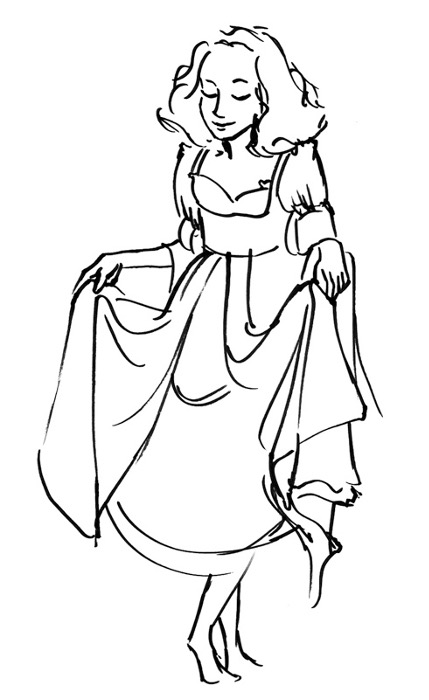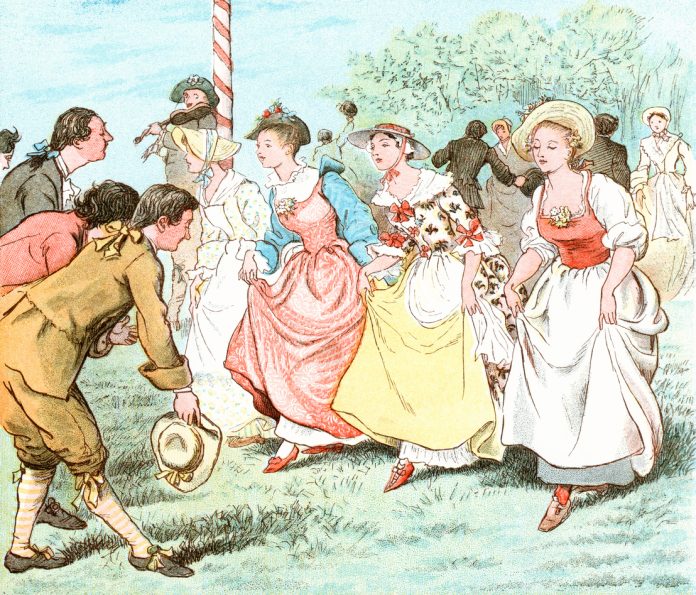Women in traditional European culture were expected not to bow and remove their hats (as men did) but instead to perform an alternative but equally courtly salutation. It took the form of the deep curtsey. And again, it was to be executed slowly, with grace and dignity. In other words, this manoeuvre was a way of indicating due deference without in any way acting slavishly

It may be noted, meanwhile, that in some cultures, women as well as men did bow as a form of greeting. That was a traditional convention – for example, in Japan. These were matters of world-regional customs – and also of routine styles of clothing. Thus women in sleek kimonos could simply bow deeply from the waist, whereas executing deep curtseys in such garb would have been more problematic.
Reverting to the British case, the highest-ranked person, in any encounter, would remain either seated or standing, with head held high. Meanwhile a woman of ‘lower’ status who sought to offer a respectful salutation, would advance one foot slightly in front of the other, bends her knees, and then slowly sink her entire body downwards, whilst keeping the spine straight. At the same time, she would hold out her full skirts on each side (thus helping to maintain her balance) and bow her head slightly – or at least cast her eyes down.
Again, this form of graceful and almost balletic salutation was much easier to perform by the young and agile. There were rumours in the eighteenth and nineteenth centuries that elderly ladies at the royal court were unable to get up again, after sinking down into a deep curtsey. In such tricky circumstances, page-boys would creep up quietly from behind and provide sufficient discreet leverage to get the elderly ladies upright again.
Greeting the Queen
So far such stories remain unverified. Yet there is always scope for conventional formalities to be unwittingly disrupted. In very recent times, one minor mishap was caught on camera. In 1990, at a garden reception at Holyrood Palace in Edinburgh, Queen Elizabeth II was welcoming guests with a handshake (something that Queen Victoria would never have done).
Yet times have changed; and greeting styles have become hybridised. A man today would take the Queen’s hand and bow; a woman would do the same and curtsey. Indeed, the young woman in this case did just that. But she stumbled, while clasping the Queen’s hand and attempting a curtsey. (Perhaps her high heels got stuck in a clump of grass). At any rate, Queen Elizabeth II was quick-witted enough to haul on the women’s hand to hold her up and avert a social catastrophe.
This encounter made for an enormously popular social media clip on Tik-Tok. Look, the Queen is human – and kindly. She did not shout ‘Off with her Head!’ when one of her subjects failed to greet her in suitably submissive style. Instead, she gave a helping hand – and, afterwards, she laughed, pleasantly, not jeeringly. ‘God save the Queen with her sense of humour’.
There is no tally of historic cases when curtseying ladies (young or old) failed to get it right. These things were undoubtedly topics for gossip and laughter at the time. And women who knew that they were likely to appear in court would practice their salutations, so that they were well prepared.
In general, however, the strong conventions of polite behaviour at the royal court brushed over occasional lapses. It was much more important to uphold the mystique of monarchy than to ridicule individual ‘subjects’ who got things wrong.
Brisk bob
Given the challenges of getting the deep curtsey absolutely right, it was not surprising that simpler alternatives quickly evolved. Thus, alongside the deep curtsey, there was also the option of the brisk body bob. Among other things, it saved time.
For example, the maidservant of a grand lady would not hang around, doing a deep curtsey every time she saluted her mistress. But a brisk bob – keeping the spine straight and quickly dipping he body down and up – would indicate respect and would then allow her to run speedily about her mistress’ business.
As a result, the slowest and most careful of curtsies were those offered to royalty at court, or on grand ceremonial occasions, such as a coronation. At polite society dances, too, male and female participants would bow and curtsey briefly to one another, before taking to the floor. But such salutations would be distinctly abbreviated – almost part of the dance – in comparison with the full court rituals.
Out of doors, however – and in all circumstances where speed was useful – a brisk bob of the body was increasingly substituted. It was much more practical. Just as men, over time, touched or pulled their caps, rather than removed them entirely, so female rituals were adjusted. When walking in crowded cities, for example, it was easy enough to bob the body and to nod the head when meeting many acquaintances. Whereas it would be impossible to give deep curtsies at every turn in a busy metropolitan high street.
Not only that, but – as in the case of ‘hat honour’ – some people began to reject the conventional curtsey altogether. The Quakers were leaders in this move. They were members of the radical Protestant church, founded be George Fox in 1656; and they believed staunchly in the equality of all men and women in the eyes of the Lord.
The handshake
Quaker women were therefore among the earliest females in Britain to embrace the handshake, as a daily salutation, and to reject both the deep curtsey and the brisk body bob. True, they might lower their heads slightly and respectfully, if shaking hands with a real grandee. In general, however, their social philosophy was simply expressed with an egalitarian handshake.
By the end of the eighteenth century, moreover, the habit of regular curtseying from social ‘inferiors’ every time that they were face-to-face with a social ‘superior’ was fast dying out.
On the busy streets of Britain’s fast-growing towns, it was not feasible to calculate instantly everyone’s relative social rankings. And anyway, even if everyone’s occupation was fully known, it was still not clear whether a middle-class master tailor and his wife (say) were ‘higher’ or ‘lower’ in status than (say) a middle-class master butcher and his wife. A brisk handshake would politely resolve any such dilemmas.
Rural society was slower to change. But social customs spread gradually from town to countryside. One relevant testimony survives, in the memoirs of Elizabeth Ham (1783-1859). She was the daughter of a Somerset yeoman farmer and brewer. And she had a somewhat disrupted upbringing, before later establishing herself as a writer.
Thinking of her country childhood, Elizabeth Ham later recalled:
“I used to curtsy to all the fine-dressed ladies that I met, till told not to do so by the nurse-maid, with whom I generally walked out.”
That recollection was doubly interesting. In the first place, it indicated that the family nurse-maid played a significant role in the upbringing of her charge. And secondly, it showed that customary greetings were changing, not just insensibly but sometimes in response to direct instructions.
Clearly, the nurse-maid thought that the young Elizabeth Ham’s behaviour was too ‘rustic’ and old-fashioned. Ham took the hint and changed her ways.
Women and men share the same styles of greeting
People still greet one another. That remains a constant. Yet the forms of salutation are never fixed in stone. Women and men these days share the same styles of greeting. The curtsey may still be performed by a ballerina when acknowledging applause at the end of a show. Yet the curtsey as a daily salutation from ‘lower’-status women to their ‘superiors’ has completely disappeared.
And a good thing too! say all ladies with poor balance and/or with creaking joints. They struggled not only to sink their bodies downwards gracefully but especially to arise again with dignity – whilst simultaneously holding out their full skirts and casting their eyes down. Phew! Let’s shake hands instead! …
For further information:
References to the history of the curtsey can be found in Penelope J. Corfield, ‘Dress for Deference and Dissent: Hats and the Decline of Hat Honour’, in journal Costume, 23 (1989), pp. 64-79; also published in German translation in K. Gerteis (ed.), Zum Wandel von Zeremoniell und Gesellschaftsritualen in der Zeit des Aufklärung, special edn. of Aufklärung, 6 (1991), pp. 5-18; and available on PJC website: www.penelopejcorfield.com/British-history/3.2.2 (Pdf/8). There is no specialist book on this topic but a brief account is available in https://en.wikipedia.org/wiki/Curtsy.








